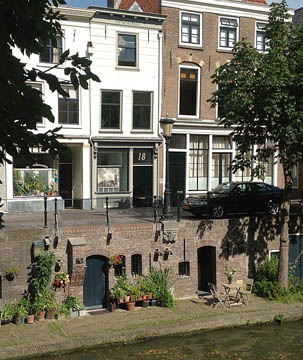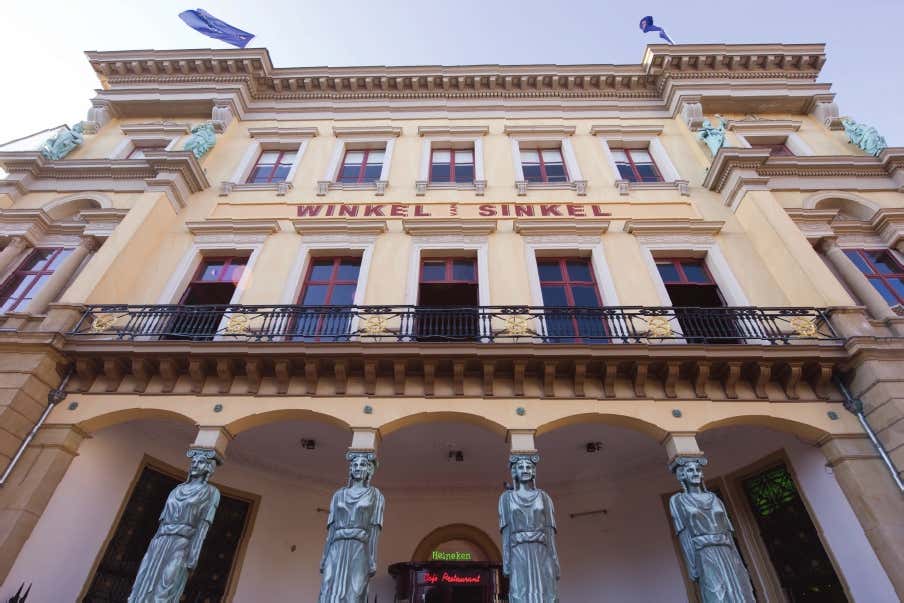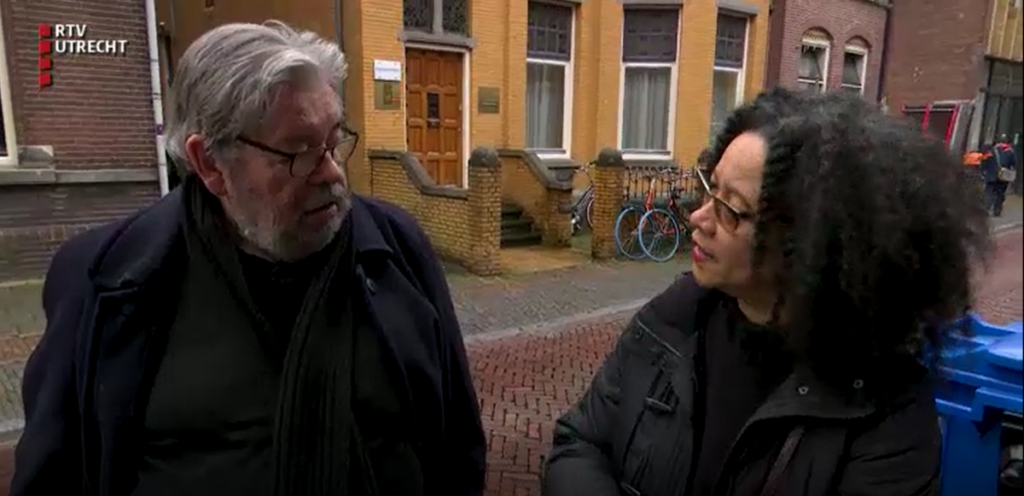“Adjacent to the wharf-level warehouse at Oudegracht 20, we find a streetlight on a sculpted pedestal depicting four shackled men. On their shoulders, they carry a man who is smoking a pipe. In the background, we see palm trees.”
This is one of many texts you can find in the walking guide of the project: “Traces of Slavery in Utrecht”. I would have never noticed this lamppost if it weren’t for this project. It reminds you that traces of colonialism and slavery are still present in the public space. Not just in cities like Amsterdam or Middelburg, but around the corner.

It is hard to believe that ‘your’ beautiful city had anything to do with slavery. But the traces are definitely there. According to historian Nancy Jouwe, the information about the Dutch history of slavery needs to be widely shared. People have to understand that traces of slavery are everywhere. The lack of attention to slavery heritage in the Netherlands bothered Nancy Jouwe. So, she decided to do something about it.
Kosmopolis Utrecht initiated “Traces of Slavery” in 2011 with Nancy Jouwe as their director. The project led up to the remembrance and celebration of 150 years of abolition in 2013. “Traces of Slavery Utrecht” is part of a public history project called “Mapping Slavery” which Dr. Dienke Hondius initiated in 2013. “Mapping Slavery” is currently led by Nancy Jouwe.
Remembrance
Kosmopolis Utrecht was up until 2013 part of the foundation Vrede van Utrecht. The municipality of Utrecht, the national government, and the cultural participation fund subsidized the centre until 2013. Kosmopolis Utrecht registered as a foundation at the chamber of commerce in 2014.
“Traces of Slavery” fits in well with the objectives of Kosmopolis. One of their main goals is to develop and strengthen intercultural connections in neighborhoods, in the city, and country. You can read the other objectives of Kosmpolis here (in dutch). The overarching goal of this project is the process of remembrance.
Both the website of Kosmopolis Utrecht and “Traces of Slavery” are somewhat dated. They probably didn’t update the website after 2013. If you are interested in the “Traces of slavery Utrecht” I advise you to take a look at the site of “Mapping Slavery”. Whereas “Traces of Slavery Utrecht” is a local project, “Mapping Slavery” is larger and international. On the website of “Mapping Slavery,” you can find maps of numerous Dutch cities and New York. Right now, they are developing maps for Indonesia which the Dutch colonized.

Photo credit: Wandelgids Sporen van Slavernij in Utrecht.
Active engagement
The project is well done. For a local project, it is quite extensive. Kosmopolis organized many different activities at the start of the project like Keti Koti tables and public lectures about slavery. Nancy Jouwe worked with a network of activists, musicians, and researchers. Together they developed a guided city tour of 7 km through the city of Utrecht. It is a good tour because it works. Many people have written about “Traces of Slavery”. They all agree on one thing: they didn’t know that slavery is a part of the history of Utrecht.
I recommend watching this YouTube video (in Dutch) by Culturele Zondagen to get acquainted with the walking tour. If you’re a fan of historian Maarten van Rossem than this video (in Dutch) is a great watch as well. After watching these videos, you’ll understand that Nancy Jouwe is the driving force behind this project. She is passionate and conveys her message well. It was during the first year of my bachelor’s that she accepted my invitation for a debate I organized. It was a very small-scale debate about systemic discrimination in the Netherlands . Also, I didn’t have any experience as a moderator. But she was still grateful to be a panelist and be able to talk about what is important to her.

The city as an archive
The subject of slavery heritage in Utrecht receives a fair amount of media attention. The effort that went into “Traces of Slavery” is one of the reasons why people talk about it. The municipality of Utrecht contacted Nancy Jouwe in March 2020 to research the history of slavery in Utrecht more. The municipality set aside an amount of 40.000 euros for the research project. On top of that, the municipality announced that Utrecht will get a slavery monument in 2023. According to the city council “The monument is a visible recognition of the suffering that slavery has caused for centuries and leaves its mark on many people to this day”.
Walking through the city with this newfound information you’ll realize that the city can function as an archive. If you pay attention, you can see little bits and pieces of history all throughout the city. I’m thankful for “Traces of Slavery” because they made it easy to learn more about Utrecht’s colonial and slavery heritage.
Has this article piqued your interest? Then make sure to check the website and find out more about the history of your city.
Written by Floor Mulder
